Are you looking for a new nickel coin to add to your collection? Or perhaps, your curiosity about US coins has brought you here. If yes, then you should take a look at the 1974 nickel. While it’s not made of precious metals, it’s an old coin that could potentially increase the value of your collection. Read on to learn more!
What Is the 1974 Jefferson Nickel Made Of?
The 1974 Jefferson nickel is made of 75% copper and 25% nickel. It has a mass of 5 grams and a diameter of 21.21 millimeters. This 5-cent coin has a plain edge and was once called “Wartime Nickels” from 1942 to 1945, composed of copper, silver, and manganese. The US Mint needed to remove nickel from the 5-cent coin because nickel was needed to win the war against the Axis power.
The 1974 nickel design includes Thomas Jefferson on the obverse and his mansion, Monticello, on the reverse. Felix Schlag prepared the original design, which was used from 1938 to 2004. The image of Jefferson was changed to an image that faces forward, which Jamie Franki designed.
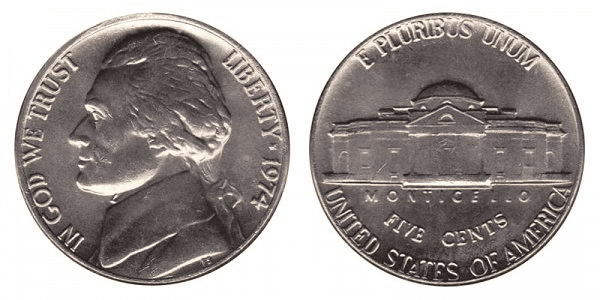
The Jefferson nickel replaced the Buffalo (Indian Head) nickel. Although the Buffalo nickel is considered today a beautiful design, it is difficult to mint, and its lifespan is too short. It easily breaks, and the surface can quickly get scratched. So, after 25 years of minting, the Jefferson nickel was born.
The US Mint announced that there would be a design competition. Initially, only a few people joined. However, when the time was almost over, many artists submitted their work. It shows that many were interested in winning the competition because of the $1,000 prize.
Eventually, Felix Schlag won the competition. The US president at that time, Roosevelt, also liked the design of Schlag as well as Nellie Tayloe Ross, the mint director.
1974 Jefferson Nickel Varieties
The 1974 Jefferson nickel comes in three varieties. The difference among these varieties isn’t much except that they have different mint marks and whether they are proof or not.
Here’s a quick look at these nickels:
| Variety | Mint Location | Mintage |
| 1974 D Jefferson Nickel | Denver | 277,373,000 |
| 1974 P Jefferson Nickel | Philadelphia | 601,752,000 |
| 1974 S Proof Jefferson Nickel | San Francisco | 2,612,568 |
| Total | 881,737,568 |
The Denver, Philadelphia, and San Francisco mints produced more than 881 million nickels in 1974. This is higher than the mintage figure of the previous year.
With that said, let’s go deeper into each of the 1974 Jefferson nickel varieties:
1974 D Jefferson Nickel
Edge: Plain
Mint Mark: D
Place of minting: Denver
Year of minting: 1974
Face Value: $0.05 (five cents)
Price: $0.10 to $0.20 (circulated condition)
Quantity produced: 277,373,000
Designer: Felix Schlag
Composition: 75% Copper, 25% Nickel
Mass: 5.00 grams
Diameter: 21.20 mm
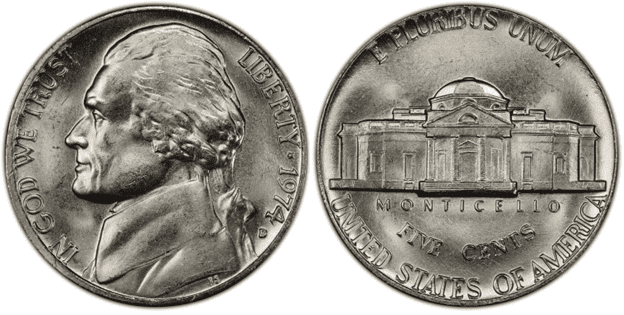
The 1974-D nickel should be easy to find in grades up to MS66. It is also inexpensive. However, nickels in MS66 and higher grades with Full Steps designation are difficult to find, and you should be ready to shell out a bigger amount of cash if you want to buy them.
1974 P Jefferson Nickel
Edge: Plain
Mint Mark: none
Place of minting: Philadelphia
Year of minting: 1974
Face Value: $0.05 (five cents)
Price: $0.10 to $0.20 (circulated condition)
Quantity produced: 601,752,000
Designer: Felix Schlag
Composition: 75% Copper, 25% Nickel
Mass: 5.00 grams
Diameter: 21.20 mm
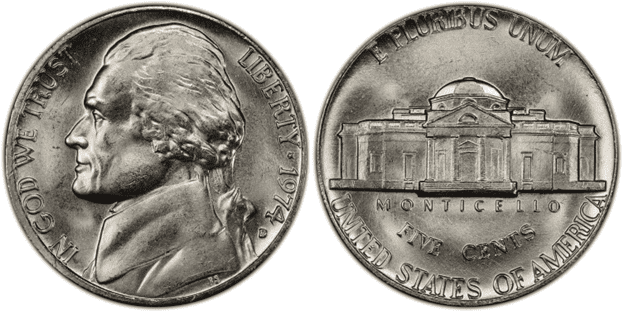
The Philadelphia Mint produced more than 600 million nickels in 1974, the highest mintage for a particular mint. Finding a 1974 P nickel up to MS 65 condition should be fairly easy. However, starting from MS66, the 1974-P nickel became scarce and more valuable. 1974 P nickel with a grade of MS67 and above is extremely rare.
1974 S Proof Jefferson Nickel
Edge: Plain
Mint Mark: S
Place of minting: San Francisco
Year of minting: 1974
Face Value: $0.05 (five cents)
Price: $0.10 to $0.20 (circulated condition)
Quantity produced: 2,612,568
Designer: Felix Schlag
Composition: 75% Copper, 25% Nickel
Mass: 5.00 grams
Diameter: 21.20 mm
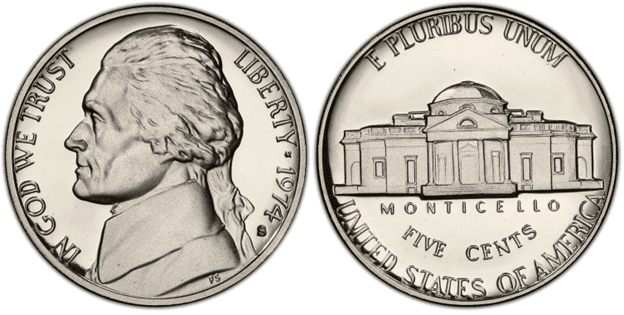
The 1974 S nickel is fairly common and inexpensive. Because of the advanced minting technique used in 1974, proof coins are more detailed, and many came out with a Deep Cameo rating. However, the perfect PR70 is the rarest, and only a few have them.
List Of 1974 Jefferson Nickel Errors
There were more than 881 million nickels issued in 1974. So, it’s no wonder that there might be some Jefferson nickels that were made with errors. Here are some examples you need to know:
Annealing error
The annealing error happens due to the coin’s improper heating and cooling process. Because of this error, you’ll notice discoloration on the coin’s surface.
Here’s what an annealing error can look like in a 1974 nickel.
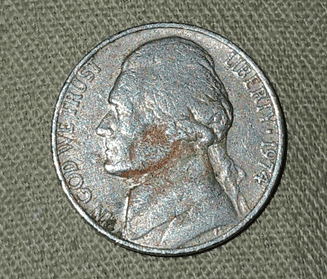
Clipped planchet
During the cutting of the coin, there’s a misalignment in the feeder. So, when the cutting blade hits the metal sheet, it includes the cut portion of the previous coin, leaving the current coin with a clipped edge.
The clipped planchet error looks like this on a 1974 nickel:
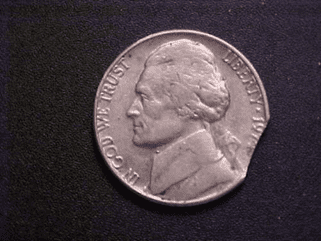
Double struck off-center error
This one is particularly rare and interesting. The coin was struck twice. The second strike was 90% off-center.
Here’s how it looks:
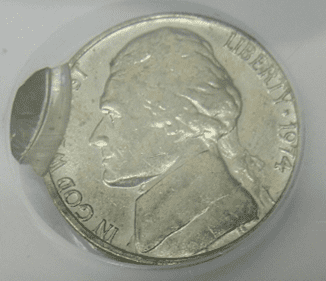
How Much Is 1974 Jefferson Nickel Worth Today?
The 1974 Jefferson nickel isn’t that valuable if you’re going to look at its face value and melt value. For example, the face value of the 1974 nickel is 5 cents. Its melt value is $0.0640. Circulated nickels might be just below 30 cents.
However, that doesn’t mean that all 1974 Jefferson nickels are cheap. Remember, a 1974 Jefferson nickel is an old coin. So, it is a coin worth more than its face value.
Take a look at this table of auction records to fully appreciate the value of the 1974 Jefferson nickel:
| Coin | Condition | Grade | Sold date | Sold by | Value |
| 1974 P Jefferson Nickel | Super Gem Uncirculated | MS 67 – Full Steps | December 3, 2020 | Legend Rare Coin Auctions | $4,230 |
| 1974 S Proof Jefferson Nickel | Perfect Uncirculated | PR 70 – Deep Cameo | July 20, 2015 | Stack’s Bowers | $3,819 |
| 1974 D Jefferson Nickel | Superb Gem Uncirculated | MS 67+ | April 26, 2015 | Heritage Auctions | $1,645 |
As you can see, the 1974 nickel coin can still be valuable. Aside from that, keep your eyes open for nickels with error coins. Sometimes, these coins are rare and command a great premium.
How Does The Grading System Work?
Professional numismatists joined in the 1970s and established CoinGrading standards, known as the Sheldon Scale. These numismatists now assign grades at key places on the seventy-point scale, using the most regularly utilized numeric points in conjunction with the original adjective grade. The following are the most common coin grades:
- (P-1) Poor – Indistinguishable and probably damaged; if used, must have a date and mintmark; otherwise, rather battered.
- (FR-2) Fair – Nearly smooth, but without the damage that a coin graded Poor often possesses. The coin must have enough detail to be identified.
- (G-4) Fair – Inscriptions have merged into the rims in some areas, and important elements have been mostly erased.
- (VG-8) Very Good- A little weathered, but all primary design elements are visible, albeit faintly. There is little, if any, central detail left.
- (F-12) Good – The item is very worn, yet the wear is even, and the overall design details stand out clearly. Rims are almost completely isolated from the field.
- (VF-20) Very Fine – Moderately weathered, with some finer features still visible. The motto or all letters of LIBERTY are readable. Both sides of the coin have entire rims separated from the field.
- (EF-40) Extremely Fine – Gently used; all gadgets are visible, and the most important ones are bold. The finer details are bold and clear; however, light wear may be seen.
- (AU-50) Uncirculated – Slight evidence of wear on the coin’s design’s high points; it may have contact marks; eye appeal should be adequate.
- (AU-58) Uncirculated Choice – Slight traces of wear, no severe contact marks, almost full mint shine, and great eye appeal.
- (MS-60) Mint State Basal – Strictly uncirculated; no indication of wear on the coin’s highest points, but an unsightly coin with reduced luster, visible contact marks, hairlines, and other flaws.
- (MS-63) Mint State Acceptable – Uncirculated, but with contact scratches and nicks, little reduced shine, but otherwise appealing appearance. The strike is weak to average.
- (MS-65) Mint State Choice – Uncirculated with great mint shine, little contact blemishes, and exceptional eye appeal. The strike is unusually severe.
- (MS-68) Mint State Premium Quality – Uncirculated with superb luster, no obvious contact marks to the naked eye, and exceptional eye appeal. The strike is quick and appealing.
- (MS-69) Almost Perfect Mint State – Uncirculated with perfect brilliance, a sharp and appealing strike, and extremely good eye appeal. A near-perfect coin with minor imperfections in the planchet, strike, and contact markings (seen only under 8x magnification).
- (MS-70) Mint State Perfect – Under 8x magnification, no tiny imperfections are discernible; the strike is crisp, and the coin is perfectly centered on a beautiful planchet. Rarely seen on a coin, this coin is bright and whole, with original luster and exceptional eye appeal.
Moreover, a 1974 nickel would also be categorized as MS or PR. MS means Mint State, given to coins originally made for circulation. PR means Proof, which is given to coins originally made for collectors.
Where To Buy Or Sell 1974 Jefferson Nickel?
You can consider different options when buying or selling a 1974 Jefferson nickel. These are the following:
- Coin dealers – there are a lot of coin dealers spread throughout the United States. You can check your local yellow page and directories or search for them online. Usually, these coin dealers would also have their websites for people.
- Online auction sites – eBay, Heritage Auctions, and Stack’s Bowers are some of the most popular websites where you can buy and sell Jefferson nickels.
- Online marketplaces – Amazon and Etsy are the most popular marketplaces today. Go to their website and search for 1974 Jefferson nickels.
- Social media websites – Facebook has a special feature called Facebook Marketplace. You can post your nickel on their website, or you can search for nickels that might have been available online. Aside from that, you can post on Instagram and Twitter. You can also search for social media groups and pages specializing in buying and selling Jefferson nickels.
Be sure to only transact with trusted vendors. There are a lot of scammers out there who will sell you fake coins or give you misleading information.
FAQs
What is the 1974 Nickel error?
There are different types of 1974 nickel errors. It can be due to mechanical or human error. Some examples include doubled die, repunched mintmark, clipped planchets, and others.
Is a 1974 nickel silver?
No, the 1974 nickel is not made of silver, but rather, it is made of copper and nickel.
Where is the mint mark on 1974 nickel?
The mint mark on a 1974 nickel is found on the obverse side of the coin. You should be able to find it just under the number 4 of 1974, to the right tip of Jefferson’s ponytail.
1973 Lincoln Penny Value Guide (Incld. Rare Varieties)
1973 Jefferson Nickel Value Guide
1973 Washington Quarter Value Guide
1974 Kennedy Half Dollar Value Guide (Incld. Rare Varieties)
1974 Washington Quarter Value Guide
1975 Dime Value Guide (Incld. Rare Varieties)
1975 Penny Value Guide (Incld. Rare Varieties)
